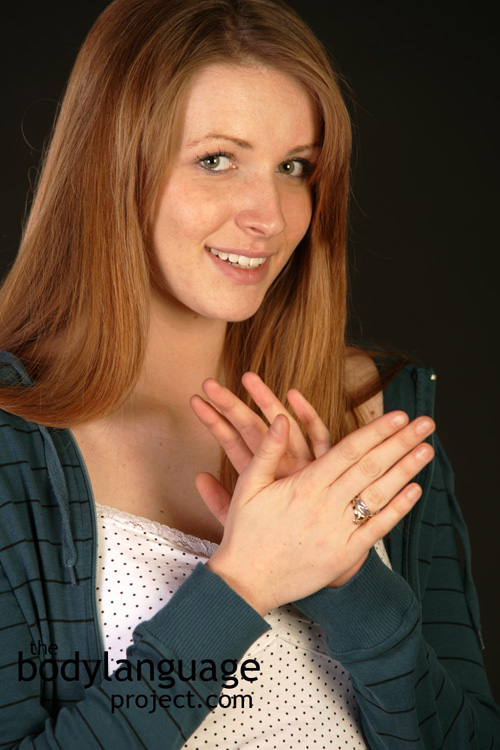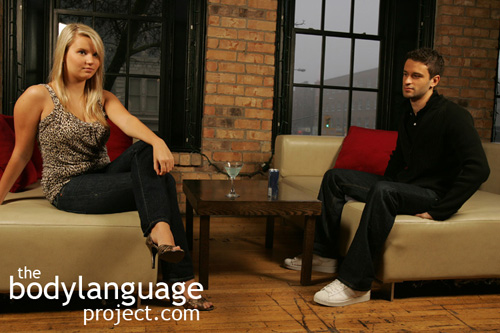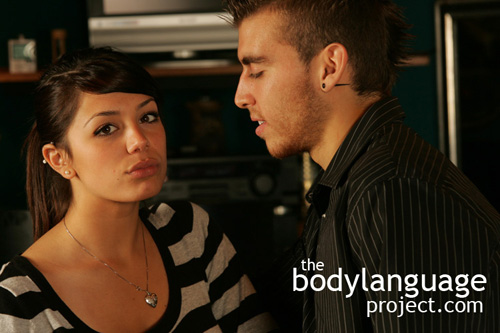Body Language of Face Platter
Synonym(s): N/A
Description: A gesture done by resting the chin on the backside of the hands or in the palms of the hands. The elbows are usually propped up on a table providing additional support to the chin and head.
In One Sentence: The face platter is a positive courtship type gesture used to place full emphasis on the face.
How To Use it: Women can use the face platter to show men that they are keenly interested in what they are saying while at the same time putting their face in full view. The hand position serves to highlighted thief faces. In a general setting, the face platter can be used to show others that you are focused on what they are saying and given them your undivided attention.
Context: a) General b) Dating.
Verbal Translation: “I’m serving my face up on a platter so you can have the best view of it – like a trophy on display.”
Variant: See Face Palm and Double Face Palm.
Cue In Action: During coffee, she propped her elbows up on the table and placed her chin on her palms and gaze adoringly at her date.
Meaning and/or Motivation: A positive courtship gesture essentially “serving the face on a platter.” It is feminine gesture that puts the face on full display as if it should be admired.
When courtship signals are absent the face platter can mean boredom especially if no eye contact is made and the head seems to slouch.
In a friendly context, the face platter coupled with persistent eye contact, indicates high focus as if the person is studying and watching their companion.
Cue Cluster: The face platter is coupled with adoring eyes and smiling.
Body Language Category: Amplifier, Courtship displays, Indicators of sexual interest (IOsI), Liking.
Resources:
Borkenau, P. (1991). Evidence of a correlation between wearing glasses and personality. Personality and Individual Differences, 12, 1125-1128. doi:10.1016/0191-8869(91)90074-L
Cash, T. F., Dawson, K., Davis, P., Bowen, M., & Galumbeck, C. (1989). Effects of cosmetics use on the physical attractiveness and body image of American college women. Journal of Social Psychology, 129, 349-355.
http://bodylanguageproject.com/articles/science-makeup-how-to-use-it/
Chao, A., & Schor, J. B. (1998). Empirical tests of status consumption: Evidence from women’s cosmetics. Journal of Economic Psychology, 19, 107-131.
Franzoi, S. L. (2001). Is female body esteem shaped by benevolent sexism? Sex Roles, 44, 177-188.
Charles v. Ford, Lies! Lies! Lies!: The Psychology of Deceit (Washington, DC: American Psychiatric Press, Inc., 1996), 200.
Dimond, Stuart ; Harries, Rashida. Face touching in monkeys, apes and man: Evolutionary origins and cerebral asymmetry. Neuropsychologia. 1984. 22(2): 227-233.
Edwards, K. (1987). Effects of sex and glasses on attitudes toward intelligence and attractiveness. Psychological Reports, 60, 590.
Guéguen, Nicolas. Makeup and Menstrual Cycle: Near Ovulation, Women Use More Cosmetics. The Psychological Record. 2012, 62, 541-548.
http://bodylanguageproject.com/articles/women-use-makeup-fertile/
Guéguen, Nicolas. Brief Report: The Effects of Women’s Cosmeticson Men’s Approach: An Evaluation in a Bar North American Journal of Psychology. 2008. 10 (1): 221-228.
Guéguen, Nicolas and Céline Jacob. Lipstick And Tipping Behavior: When Red Lipstick Enhance Waitresses Tips. International Journal of Hospitality Management, 2012; 31: 1333– 1335.
http://bodylanguageproject.com/articles/men-prefer-women-who-dress-in-red-and-wear-red-lipstick-how-to-earn-more-tips-or-favours-from-men/
Guéguen, Nicolas. Hair color and wages: Waitresses with Blond Hair Have More Fun. The Journal of Socio-Economics. 2012. 41: 370-372.
http://bodylanguageproject.com/articles/research-says-blondes-fair-better-tips-courtship-donations-spontaneous-helping/
Guéguen, Nicolas. Hair Color and Courtship: Blond Women Received More Courtship Solicitations and Redhead Men Received More Refusals. Psychol Stud. 2012. 57(4):369–375. DOI 10.1007/s12646-012-0158-6
Guéguen, Nicolas. Brief Report: Women’s Hair Color and Donations: Blonds Receive More Money. North American Journal of Psychology. 2011. 13(3): 367-372.
Guéguen, Nicolas. The Sweet Color of an Implicit Request: Women’s Hair Color and Spontaneous Helping Behavior. Social Behavior and Personality. 2012. 40(7): 1099-1102.
Holme, S. A., Beattie, P. E., & Fleming, C. J. (2002). Cosmetic camouflage advice improves quality of life. British Journal of Dermatology, 147, 946-949.
Harris, M. B., Harris, R. J., & Bochner, S. (1982). Fat, four-eyed, and female: Stereotypes of obesity, glasses, and gender. Journal of Applied Social Psychology, 12, 503-516. doi:10.1111/j.1559-1816.1982. tb00882.x
Harris, M.B. (1991). Sex differences in stereotypes of spectacles. Journal of Applied Social Psychology, 21, 1659–1680. doi 10.1111/j.1559-1816.1991.tb00497.x
Hasart, J. K.,&Hutchinson, K. L. (1993). The effects of eyeglasses on perceptions of interpersonal-attraction. Journal of Social Behavior and Personality, 8, 521–528.
Hellström, A., & Tekle, J. (1994). Person perception through facial photographs: Effects of glasses, hair, and beard on judgments of occupation and personal qualities. European Journal of Social Psychology, 24, 693–705. doi 10.1002/ejsp.2420240606
Jones, Alex L.; Robin S. S. Kramerb and Robert Warda. Miscalibrations in Judgements of Attractiveness With Cosmetics. The Quarterly Journal of Experimental Psychology. 2014. 64(1): 12060-2068. DOI: 10.1080/17470218.2014.908932.
http://bodylanguageproject.com/articles/dont-cake-makeup-study-finds-less-makeup-best/
Jones, Alex L and Robin S. S. Kramer. Facial Cosmetics Have Little Effect on Attractiveness Judgments Compared With Identity. 2015. In Press. doi:10.1068/p7904
http://bodylanguageproject.com/articles/ditch-makeup-cosmetics-play-small-role-overall-beauty-study/
Kyle, D. J., & Mahler, H. I. (1996). The effects of hair colour and cosmetic use on perceptions of a female’s ability. Psychology of Women Quarterly, 20, 447-455.
Lundberg, J. K., & Sheehan, E. P. (1994). The effects of glasses and weight on perceptions of attractiveness and intelligence. Journal of Social Behavior and Personality, 9, 753–760.
Leder, Helmut ; Forster, Michael ; Gerger, Gernot. The Glasses Stereotype Revisited: Effects of Eyeglasses on Perception, Recognition, and Impression of Faces. Swiss Journal of Psychology. 2011. 70(4): 211-222.
Mulhern, R., Fieldman, G., Hussey, T., Le´veˆque, J.-L., & Pineau, P. (2003). Do cosmetics enhance Caucasian female facial attractiveness? International Journal of Cosmetic Science, 25(4), 199-205.
http://bodylanguageproject.com/articles/beauty-eye-holder-makeup/
Mohiyeddini, Changiz ; Semple, Stuart. Displacement behaviour regulates the experience of stress in men. Stress. 2013. 16(2): 163-171.
Nash, Rebecca; George Fieldman; Trevor Hussey; Jean-Luc Le Ve Que and Patricia Pineau. Cosmetics: They Influence More Than Caucasian Female Facial Attractiveness
Journal of Applied Social Psychology. 2006. 36(2):493-504.
Porcheron, Aurélie; Emmanuelle Mauger; Richard Russell. Aspects of Facial Contrast Decrease with Age and Are Cues for Age Perception. PLoS ONE, 2013; 8 (3): e57985 DOI: 10.1371/journal.pone.0057985.
Pease, Barbara and Allan Pease. 2006. The Definitive Book of Body Language Hardcover. Bantam.
Russell, Richard. (2010) Why cosmetics work. In Adams, R., Ambady, N., Nakayama, K., & Shimojo, S. (Eds.) The Science of Social Vision. New York: Oxford University Press. pp. 186-203
Regan, Pamela C. Cinderella Revisited: Women’s Appearance Modification as a Function of Target Audience Sex and Attractiveness. Social Behavior and Personality. 2011. 39(4): 563-576. DOI 10.2224/sbp.2011.39.4.563
http://bodylanguageproject.com/articles/women-wear-makeup-meeting-attractive-people/
Stillman, Jerijaynew. ; Hensley, Waynee. She wore a flower in her hair: The effect of ornamentation on nonverbal communication. Journal of Applied Communication Research. 1980. 8(1): 31-39.
Terry, R. L. (1993). How wearing eyeglasses affects facial recognition. Current Psychology, 12, 151–162. doi 10.1007/ BF02686820
Terry,R. L.,&Hall, C. A. (1989). Affective responses to eyeglasses: Evidence of a sex difference. Journal of American Optometrist Association, 60, 609–611.
Terry, R. L., & Kroger, D.L. (1976). Effects of eye correctives on ratings of attractiveness. Perceptual and Motor Skills, 42, 562. doi 10.2466/PMS.42.2.562









